Robert Bryson (1778 – 1852) was a Clock and Watch Maker of Edinburgh, as well as being Clock and Watchmaker to Queen Victoria and Co-Founder of what would become Heriot Watt University.
He had four sons and two daughters
- Alexander Bryson (1816-1886)
- William Gillepsie Bryson (1818-1906)
- Robert Bryson (1819-1886)
- Margaret Muir Bryson (1821-1873)
- James Mackay Bryson (1824-1894)
- Helen Cockburn Bryson (1826-1912)
His third son, Robert Bryson junior, married Mary Ann Braund Box (1817-1899) on 10th July 1843 – possibly at St Cuthberts, Edinburgh (although some records suggest the same date, but at her home town of Launceston, Cornwall).
Mary Ann Braund Box was the daughter of John Box (1788-1849), who was also a Watch and Clock Maker. He was also my Great Great Great Grandfather. John Box’s son William Braund Box (1815-1891), Mary’s elder brother, was also a watch and clock maker. There was clearly a close and ongoing connection between the Box and Bryson families.
Christina L. Box, eldest daughter of William Braund Box and his wife Rosina (nee Williams) was born in Holland , Edinburgh in 1848 – when her parents were probably visiting the Brysons (I am not sure where Holland in Edinburgh was). The birth was attended by Dr Simpson, after whom the Simpson Memorial Ward of the Royal Infirmary (where I was born) was named.
My Great Grandfather, John Robert Box, lived for three years with Robert Bryson junior, and John’s aunt Mary at their house in Edinburgh in the 1870s, and is recorded as a visitor there in the 1871 Census.
Traveling to Edinburgh
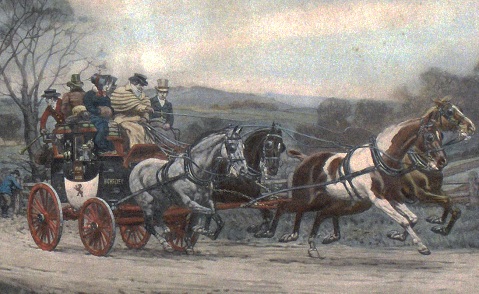
I suspect the 1843 marriage between Robert Bryson junior and Mary Box took place in Edinburgh, as they would have then set up home together. Whether it was the bride or groom who traveled, it would have been by stage coach, or possibly mail coach as the East Coast Main Line was not completed until 1846, and the Caledonian Line did not reach Edinburgh until 1848.
According to the Georgian Index web site the mail coach took about 60 hours to reach Edinburgh from London
Robert Bryson senior (1778-1852)

Born 25th August 1778 in South Leith, the son of Alexander Bryson (1740-1823) and Helen Cockburn, he married Janet Gillespie (1788-1858) on 29th December 1815 in the parish of North Leith.
They were living at 5, South Bridge in 1816 when their eldest son, Alexander, was born.
According to Smith’s (1903) A Handbook & Directory of Old Scottish Clockmakers from 1540 to 1850 A.D.
The clock he made for the Observatory, referred to above can now be seen at the Old City Observatory on Calton Hill, in its Clocks collection.
There are pictures of one of the clocks he made at http://www.british-antiqueclocks.com/stock/robert-bryson-edinburgh/
Fellow of the Royal Society of Edinburgh
He was proposed as a Fellow of the Royal Society of Edinburgh by Thomas Brisbane, 6th Governor of New South Wales, and Astronomer (after whom Brisbane, in Australia was named).
There is an article about him, and his son Alexander on the Royal Society of Edinburgh web site.
Connection with Herriot Watt University
According to the Edinburgh University History site on Leonard Horner
In 1821, Horner founded the School of Arts in Edinburgh, for the teaching of mechanics. He had been inspired by a conversation with Robert Bryson, a respected Edinburgh businessman, and owner of a watchmakers shop. The two men fell into conversation, and, prompted by a question from Horner, Bryson expressed some frustration that young men entering his trade hardly ever received any mathematical education, and that this had a negative effect on their daily lives.
Horner had an idea that a means might be devised of providing such education for the working classes. His outline of a proposed school was circulated to selected master mechanics, in order that they could gauge interest amongst their workmen. Only a month after the conversation in Bryson’s shop, a committee had formed with the purpose of bringing the plan into fruition. The first institution specifically designed to provide practical technical education for the working classes, the: School of Arts of Edinburgh for the Education of Mechanics in Such Branches of Physical Science as are of Practical Application in their several trades opened, in October 1821, in Niddry Street, Edinburgh. It was an immediate success. Probably the first institution founded specifically for the technical education of the artisan classes, the School of Arts heralded a new era in the history of education in Britain. As a result Lord Cockburn described Horner as ‘indirectly the founder of all such institutions’. Horner was also one of the founders of the Edinburgh Academy.
According to the Heriot Watt Universiy site
The lack of technical and scientific education available for workers was becoming a problem. One day, linen merchant and social reformer Leonard Horner discussed the problem with his friend clock maker Robert Bryson who was finding it difficult to obtain classes for his apprentices. They decided to solve the problem themselves, and with the support of wealthy Edinburgh citizens such as Sir Walter Scott, Lord Cockburn and the Craig family of Riccarton who agreed to give annual subscriptions to help pay for the cost of classes, set up evening classes with fees that working men could afford.
On 16th October 1821 the School of Arts of Edinburgh “for the instruction of mechanics in such branches of physical science as are of practical application in their several trades” held the first lecture in chemistry at St Cecilia’s concert hall in the Old Town. Despite criticism from the establishment fearing educating the lower classes would lead to revolution, the School also received support from The Scotsman, and within a month 452 students had enrolled. Within 30 years there were 700 Mechanics Institutes in Britain and the movement had also developed in American and Australia.
Burial
He is buried, along with several other members of the family at New Calton Burial Ground. The Find a Grave site has an entry for him.
Robert Bryson junior (1819-1886)

He lived at 17, Bruntsfield Place (OSM) from at least the 1861Census until his death on 20th March 1861.
Like his father, he was a clockmaker, employing 16 men and boys in 1861, and Clockmaker to Her Majesty (Queen Victoria) in 1871.
John Robert Box is listed as a visitor in the 1871 Census.
I inherited a silver fruit knife from him.
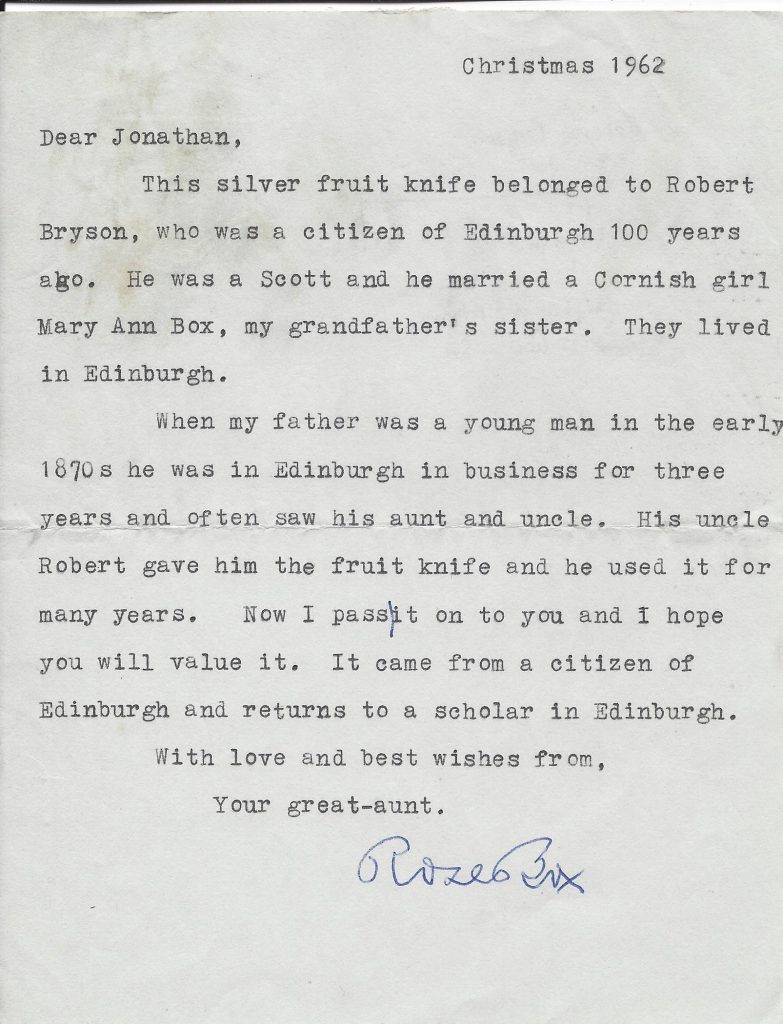
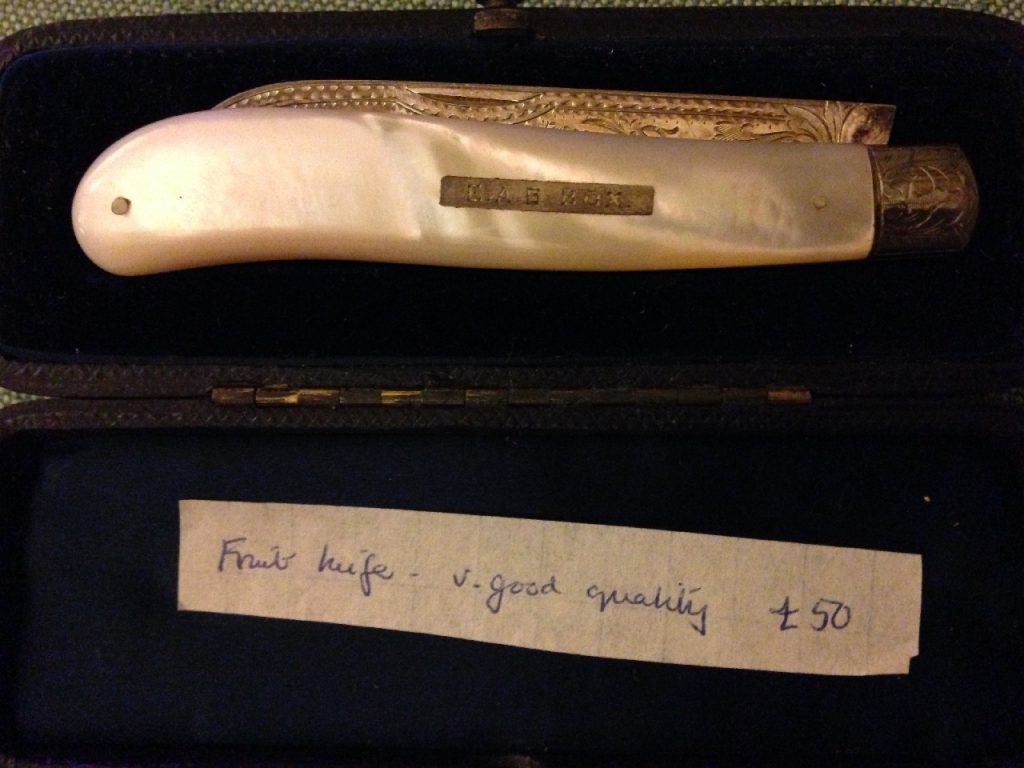
Robert Bryson’s obituary in The Scotsman on 22nd March 1886 reads
The late Mr. Robert Bryson – Edinburgh has lost a worthy citizen by the death of Mr. Robert Bryson, watch and clock maker, Princes Street. Mr. Bryson, who had been suffering for some time from a painful disease, had been practically laid aside from business for the last two months.His death, which was not unlooked for as the termination of his illness, took place on Saturday afternoon as his residence, 17 Bruntsfield Place. In public life, Mr. Bryson was chiefly associated with the Merchant Company, of which for the last twenty-eight years he was an active member and office-bearer.Four years after his admission he was elected an Assistant, and held that office from 1861 to 1864.In the latter year he was called to be Master of the Company, and filled that position with ability for three years.Of the George Watson, James Gillespie, and Daniel Stewart Trusts, which are managed by the Company, he was a Governor.Of the Merchant Maiden Hospital he was a Governor for twelve years.To its affairs he devoted much time, particularly to the management of the Peterhead estates.In this connection he took much interest in the improvement of the harbors, and in promoting the movement for a National Harbour of refuge at that port.For five years (1874-9) Mr. Bryson was one of the trustees, and for two years honorary collector, of the institutions in which he took a kindly concern was James Gillespie’s Hospital, of which for six years he acted as treasurer with the view of saving expense in the management at a time when the income was not so large as it is now.The welfare of the old people who resided in the Hospital was near to his heart, and he did much to promote their happiness and comfort.The feuing arrangements of the hospital property were also to him a subject of consideration, and he had not a little to so with the negotiations which led to the formation of the Colinton Road bridge. But, indeed, there was no department of the Company’s business which did not benefit by his advice and labours.One other scheme which may be specially mentioned as having his active support was the Provisional Order under which the splendid schools of the Company were organized.When he retired from the Mastership in 1877, a cordial and unanimous vote of thanks was awarded to him “for the great interest he has taken in the affairs of the Company, and for the efficient manner in which he had fulfilled the duties of the chair. ”Since 1876 he has been the Company’s representative at the Leith Dock Commission, and has taken a full share of the work of management of the port and harbour of Leith.At other public boards he was also useful and welcome member.He was one of the managers of the Infirmary, appointed by the contributors, chairman of the Royal Asylum, chairman of the Scottish Trade Protection Society, a director of the Watt Institution and a life member of the Heriot-Watt Trust, a governor of Trade Maiden Hospital, a manger of the Savings Bank, a J.P. for the city, one of the Council of the Dean Guild Court, and for some years auditor of the city accounts.By all with he was associated in these public offices he was held in regard, and his death will be mourned not only by his family, but by a wide circle of friends.
Bryson Road (OSM) in Edinburgh was named after him.
BRYSON ROAD After Robert Bryson, watchmaker, member of the Merchant Coy. Master of the Merchants Coy. 1874-76. Superiors of the grounds.
Burial
He is buried at Warriston Cemetery, along with Mary, in section A2 #538, with a monument by Thomas Stuart Burnett. Unfortunately his monument has been vandalised, as there was presumably some sculpture, which is now missing.
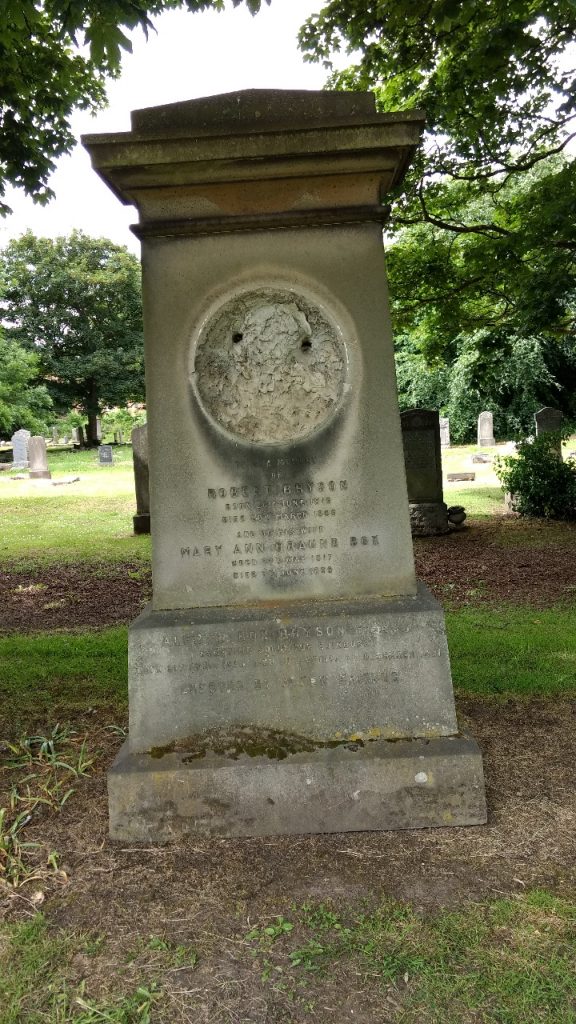
The inscription on the main part of the monument reads
TO THE MEMORY
OF
ROBERT BRYSON
BORN 26TH JUNE 1819
DIED 20TH MARCH 1886
AND OF HIS WIFE
MARY ANN BRAUND BOX
BORN 27TH MAY 1817
DIED 9TH JUNE 1899
Also in the base of the monument are other inscriptions related to other family members.
Elizabeth Box, died 16th August 1852, aged about 26, was the younger sister of Mary Ann Braund Box, and lived with her and Robert at 65, Princess Street in the 1851 Census.
Elizabeth Box Bryson (27th January 1853 – 9th January 1916) was the daughter of Robert and Mary Ann Bryson. She died, a spinster, aged 62.
Alfred Box Bryson (21st April 1855 – 7th December 1931) was the son of Robert and Mary Ann Bryson. He was a writer and Solicitor, and married Edith Baldwin, having a daughter, Elizabeth S. Bryson in 1894. He died in South Africa, aged 76, four years after Edith died.
Edith May Baldwin (1857 – 27th May 1927) was the daughter of Charles Almon Baldwin of Richmond, Virginia, and was born in the US.
Above is a rough map of how to get to the monument, next time I go I will make a more detailed track. Basically go in the entrance
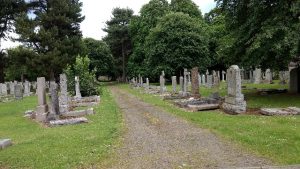
and turn off at a path looking like this to the left.
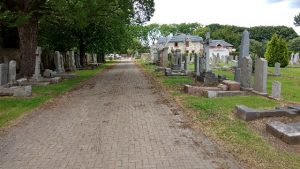
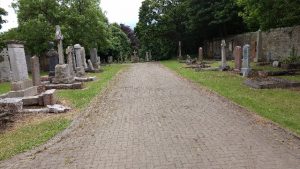
and the way ahead should look like this, but this is the main cemetery road which you turn off from.
Follow this wide path towards the north of the cemetery. Then turn right when you reach another wide path, and then right again. You should be able to find the monument, to your right, less than ten monuments along.
Sale of Bryson and Son to Hamilton and Inches
In 1893 Hamilton and Inches acquired established clock makers Robert Bryson & Sons. Hamilton and Inches, established 1866, started as a goldsmiths and jewellers, and by 1893 were at 87,88 Princess Street. They are still in business, and are now Silversmiths and Clock specialist by Appointment to Her Majesty the Queen, and based at 87, George Street.
Alexander Bryson (1816-1866)
Alexander Bryson married three times.
His third wife was Jane Thompson (1836-), and they had a son, Leonard Horner Bryson, presumably named after Leonard Horner, so presumably they maintained a connection. I think Jane Thompson remarried William H Hardie (1832-), a farmer, and Leonard Horner Bryson (who became a surgeon), lived with them in the 1881 Census.
William Alexander Bryson (1855-1906)
The fifth child of Alexander Bryson by his first wife, Elizabeth Waterstone Gillespie, was a William Alexander Byson, born 2nd March 1855. His mother died 10th April 1855, and by the 1861 Census, Alexander Bryson was a single parent, with daughter Margaret Gillespie, aged 8, William Alexander, aged 6 and Donald Cuthbert, aged 2. By the 1871 Census. William Alexander is, probably, a scholar at Abbey Park, in St Andrews, aged 15. This was a boarding school run by the father of Donald MacKenzie Smeaton, who became MP for Stirlingshire. By the 1881 census, William Alexander is living with his uncle, Archibald Richie Gillespie in Leith, and his occupation is Marine Engineer. He married Edith Agnes Smith (born 1866), and they had a daughter, Alice S.M. Bryson, born about 1890. He was the creator of the public electric lighting system in Leith in 1897 (one of the first in the world).
Like Robert Bryson senior and Alexander Bryson he was a Fellow of the Royal Society of Edinburgh. One of his proposers was William Thomson (Lord Kelvin). He was elected to the Royal Society of Edinburgh on 2nd April 1888. There was a probate record for a “William Alexander Bryson of 37, Park Road, Leith, who died 9th July 1906, confirmation of Edith Agnes Smith or Bryson widow, sealed, London.”, but 37, Park Road Leith is occupied by Paul Helm, Retired Supervisor Inland Revenue in the 1901 Census. (William Alexander Bryson, and Edith Agnes Bryson, and Alice were living at 9, Stanley Road, Kinseroft, Leith North, in the 1901 Census.
There is a vandalised monument (which I have not found) to him, (died June 11th 1906) in Warriston Cemetery.
There is a sketch of him by John Lavery in Glasgow Museum’s resource centre.
Hi John, Im really interested in the Bryson & Sons shop, because I believe I may have the public clock that was part of their fitment. Do you have any idea where or how I may track down an old photo or illustration of this establishment, as part of my detective work? thanks!
Was this the shop at 5, South Bridge, or the one on Princes Street ?
I seem to remember the Central Library had quite a few old pictures in its Edinburgh/Scottish section.
It may also be worth looking at web sites such as Francis Frith,
to see if they have anything.
Hi,
I have just discovered that Robert Bryson purchased the old Mint building, South Grays Close and Cowgate in 1830.
Did your research uncover any details on what he used the building for and how long the he or the family retained it in their ownership?
The building was demolished in 1877.
I had not been aware of a connection, but some searching has taken me to ‘The Book of the Old Edinburgh Club Volume 3’ which, towards the bottom of page 232 says
There is a picture (presumably a different one as the donor is not listed as Robert Bryson) of ‘The Old Scottish Mint, Cowgate,Edinburgh‘ in the National Gallery of Scotland.
I only knew of him at 8, South Bridge and then Princess Street, so this is new information for me, thank you.
Thanks for your reply.
I am sure he never lived in the Mint buildings but may have used them as accommodation for tradesmen, students or his own workers. Still to find direct evidence. The building was sold in a state of decay and the tenants were ‘tradesmen or of similar rank’. Many Cowgate buildings were demolished in the 1860s and 1870s indicating Bryson did not renovate to overcome the decay beyond what was necessary to maintain accommodation for low rent paying tenants.
I think Le Conte’s image of the Old Scottish Mint is stylised but is the interior of the quad. The “1674” refers to an inscription on a wall referenced in a book. ‘Cassel’s Old & New Edinburgh, vol 1’, Grant, 1882 I think but did not take a note at the time.
I think Robert Bryson, senior lived in Buccleuch Place in the 1841 Census and 11, Salisbury Road in 1851 – but the Census records do not show where he worked. He appears in Gray’s Annual Directory for 1832, at 8, South Bridge as a watchmaker, along with Anderson and co, Tavern Keepers; Alexander Boyack, tailor and clothier; Laurence Butters, seal engraver. This might indicate that his ownership of the Mint only lasted a short time. I assumed that he was simply a tenant in 8, South Bridge along with other tradesmen, with a tavern on the ground floor.
Good Afternoon.
My search has brought me here!
Can anyone help.
We have a family antique engraved gold pocket watch and have managed to open it up.
Inside has the following engraved:
John Bryson, 30 George IV Bridge, Edinburgh.
I have found information about Robert Bryson and his family history of clockmaking, but nothing about a John Bryson.
Any feedback/advice would be greatly appreciated.
Sue
I can not find a John Bryson in the immediate parts of the family tree I have investigated, although he could be a cousin of some kind. 30, George IV Bridge sits between my school and the Central Library, which I would often visit after school, so I have been past there many times, however the Robert Bryson premises were at South Bridge and then Princess Street.
The library of the Antiquarian Horological Society may have more information on him, when it becomes possible to visit that.
My apologies for hijacking this blog, however I can shed some light on the John Bryson that Sue asked about. As you suspected, John, he is not part of your very interesting family, but did work from George IV Bridge – not far from your school which was also the school my two sons went to.
Remarkably, there are three watchmaker families by the name of Bryson in the Edinburgh area, none related to each other to my knowledge. The most famous is the family headed by Robert Bryson; there was also a John Bryson and Son of Dalkeith. Probably the least well known was John Bryson who for over 50 years worked from premises at 29-30 George IV Bridge in Edinburgh. This note tries to shed some light on this latter John Bryson, using various online and other resources, mainly Scotlands People; Post Office Directories and Canmore.
John Bryson was born in Stenton, East Lothian, on 4th December 1834 to Adam Bryson, a market gardener, and Marion McCarter. He married Agnes Hay in 1865 in Ratho, Edinburgh. (Agnes was born about 1837/8 and died in 1907 in Musselburgh, near Edinburgh.) John and Agnes had a son, Charles Hay Bryson (who also became a watchmaker), and a daughter Jane. John died in Musselburgh in 1903.
The 1841 and 1851 Census records show John living with his parents (not surprisingly!) By the time of the 1861 Census, John was living in 2 North Newington Place (coincidentally the street which is parallel to Salisbury Road, where Robert Bryson senior lived at the time of the 1851 Census) as a tenant of Jean Ker, a widow who gave her ‘occupation’ as ‘wife of watchmaker’. I have not managed to trace a watchmaker named Ker in Edinburgh, however it could be that he was John’s tutor. The Censuses of 1871, 1881, 1891 and 1901 show John and his family living at various addresses in and around Edinburgh.
The Post Office Edinburgh & Leith Directories and the Valuation Rolls show John Bryson working as a Watch & Clock Maker and latterly as a Watchmaker & Jeweller originally at 30 and later at 29 & 30 George IV Bridge, Edinburgh between 1865 and 1915, a period of 50 years. Since John died in 1903, the latter years of this business must have been carried on by someone else – possibly his son Charles. For those who know Edinburgh, these premises are between the statue to Greyfriars Bobby and Frankenstein’s Pub. Currently it is occupied by a Scottish Souvenir shop. There is a photograph which includes the Bryson shop at night at https://canmore.org.uk/collection/1228182 – not very clear, but the name ‘Bryson’ can just about be made out on the shop front of the three storey building to the right in this picture (In front of the ‘To Let’ sign).
My interest in John Bryson started when I bought a clock face with the inscription ‘BRYSON, Edinburgh’ to complete a project. I have recently also bought a drop-dial single fusee clock at auction which has the inscription ‘Bryson, Geo IV Bridge, Edinburgh’ on the dial.
Hopefully this answers some of the questions asked about John Bryson.
Hi Sue,
I have one of these too – it’s beautiful! – and would love to know more about it.
Did you ever manage to find any info?
Chris
My father’s grandmother Ellen Bryson was the daughter of Robert Bryson’s younger brother James (once a partner in the Bryson clockmaking business according to family lore) who emigrated to Ontario Canada around 1830. It has been fascinating to learn the family history.
My third great grandfather Robert Gillespie was Janet Gillespie Bryson’s youngest brother. Janet Gillespie Bryson was Robert Bryson Sr. wife. While researching the Bryson branch of the Gillespie tree I have been fortunate to meet cousin/descendants of Robert & Janet. I have photos of all of their children except Margaret Muir Bryson. I would be more than happy to share them with you should you wish to include them in narrative.
Kind Regards,
Susan Gillespie Fregeau
Thank you, that would be fascinating. The Brysons and Gillespies are both interesting families
Hi,
Robert Bryson Sr was my great great great grandfather.
James Mackay Bryson
Archibald Gillespie Bryson
Thomas Abercrombie Petrie Hay Bryson (TA Petrie Hay on the grave at New Carlton)
Anne Weir née Bryson
Me Emma Weir
Just thought I’d say hi! We are a small family but we are Brysons still living in Edinburgh
Hi John,
Your page is very well presented and full of useful information!
Wishing to replace link towards a factual, but rather impersonal Wikipedia biography, I am at present writing a blog biography of my great grandfather, Thomas Stuart Burnett, who sculpted the medallion that has disappeared from the Bryson tombstone. It’s a real disgrace if it was stolen or vandalised – unless it fell off for another reason and is lying somewhere close by. Whatever, I would like to obtain your permission for a non-commercial reuse of your photograph of the monument. Should you agree, please note that I use a creative commons licence (https://creativecommons.org/licenses/by-nc-sa/4.0/) for my blog, but I can always state exceptions such as copyright, or a different licence, and mention the name of the author and the source of the image with a corresponding link. I know this looks terribly formal, but I like to fully respect intellectual property.
By the way, William Brodie, the sculptor of the marble bust of Robert Bryson junior, was Thomas Stuart Burnett’s employer during his apprenticeship, and in that period they worked together https://batch.artuk.org/discover/artworks/greyfriars-bobby-297113 on Greyfriars Bobby!
Best wishes,
William
You are very welcome to use the image under a Creative Commons Non-commercial Share-Alike license – nice to encounter someone who considers such things. I am pretty sure the medallion is not lying close by, so may have been vandalised, but I suspect stolen.
Many thanks for your authorisation. The blog biography of Thomas Stuart Burnett is now online, and the section about the medallion in memory of Robert Bryson, Esq. can be found here:
https://williamwalkington.blogspot.com/p/thomas-weir-stuart-burnett-1853-1888.html#Bryson
My name is Joanne Messer. My great grandfather Alexander Bryson emigrated to Canada in the early 1900s.We were in Edinburgh in 2023 and visited the New Carlton Cemetary . I would like to contact members of the family.
.